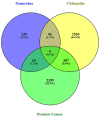A Systems Biology Approach for Investigating Significant Biomarkers and Drug Targets Common Among Patients with Gonorrhea, Chlamydia, and Prostate Cancer: A Pilot Study
- PMID: 38033384
- PMCID: PMC10683397
- DOI: 10.1177/11779322231214445
A Systems Biology Approach for Investigating Significant Biomarkers and Drug Targets Common Among Patients with Gonorrhea, Chlamydia, and Prostate Cancer: A Pilot Study
Abstract
Having a previous history of sexually transmitted diseases (STDs) such as gonorrhea and chlamydia increases the chance of developing prostate cancer, the second most frequent malignant cancer among men. However, the molecular functions that cause the development of prostate cancer in persons with gonorrhea and chlamydia are yet unknown. In this study, we studied RNA-seq gene expression profiles using computational biology methods to find out potential biomarkers that could help us in understanding the patho-biological mechanisms of gonorrhea, chlamydia, and prostate cancer. Using statistical methods on the Gene Expression Omnibus (GEO) data sets, it was found that a total of 22 distinct differentially expressed genes were shared among these 3 diseases of which 14 were up-regulated (PGRMC1, TSC22D1, SH3BGRL, NNT, CTSC, FRMD3, CCR2, FAM210B, VCL, PTGS1, SLFN11, SLC40A1, PROS1, and DSE) and the remaining 8 genes were down-regulated (PRNP, HINT3, MARCKSL1, TMED10, SH3KBP1, ENSA, DERL1, and KMT2B). Investigation on these 22 unique dysregulated genes using Gene Ontology, BioCarta, KEGG, and Reactome revealed multiple altered molecular pathways, including regulation of amyloid precursor protein catabolic process, ferroptosis, effects on gene expression of Homo sapiens PPAR pathway, and innate immune system R-HSA-168249. Four significant hub proteins namely VCL, SH3KBP1, PRNP, and PGRMC1 were revealed by protein-protein interaction network analysis. By analyzing gene-transcription factors and gene-miRNAs interactions, significant transcription factors (POU2F2, POU2F1, GATA6, and HIVEP1) and posttranscriptional regulator microRNAs (hsa-miR-7-5p) were also identified. Three potential therapeutic compounds namely INCB3284, CCX915, and MLN-1202 were found to interact with up-regulated protein C-C chemokine receptor type 2 (CCR2) in protein-drug interaction analysis. The proposed biomarkers and therapeutic potential molecules could be investigated for potential pharmacological targets and activity in the fight against in patients with gonorrhea, chlamydia, and prostate cancer.
Keywords: Prostate cancer; STD; biomarker identification; chlamydia; drug candidate; gonorrhea.
© The Author(s) 2023.
Conflict of interest statement
The author(s) declared no potential conflicts of interest with respect to the research, authorship, and/or publication of this article.
Figures





Similar articles
-
Bioinformatics Approach to Identify Significant Biomarkers, Drug Targets Shared Between Parkinson's Disease and Bipolar Disorder: A Pilot Study.Bioinform Biol Insights. 2022 Feb 23;16:11779322221079232. doi: 10.1177/11779322221079232. eCollection 2022. Bioinform Biol Insights. 2022. PMID: 35221677 Free PMC article.
-
Role of miR-452-5p in the tumorigenesis of prostate cancer: A study based on the Cancer Genome Atl(TCGA), Gene Expression Omnibus (GEO), and bioinformatics analysis.Pathol Res Pract. 2018 May;214(5):732-749. doi: 10.1016/j.prp.2018.03.002. Epub 2018 Mar 6. Pathol Res Pract. 2018. PMID: 29559248
-
Demographic, Behavioral, and Clinical Characteristics of Persons Seeking Care at Sexually Transmitted Disease Clinics - 14 Sites, STD Surveillance Network, United States, 2010-2018.MMWR Surveill Summ. 2021 Nov 5;70(7):1-20. doi: 10.15585/mmwr.ss7007a1. MMWR Surveill Summ. 2021. PMID: 34735419 Free PMC article.
-
Identification of differentially expressed genes regulated by molecular signature in breast cancer-associated fibroblasts by bioinformatics analysis.Arch Gynecol Obstet. 2018 Jan;297(1):161-183. doi: 10.1007/s00404-017-4562-y. Epub 2017 Oct 23. Arch Gynecol Obstet. 2018. PMID: 29063236
-
Network pharmacology-based identification of miRNA expression of Astragalus membranaceus in the treatment of diabetic nephropathy.Medicine (Baltimore). 2022 Feb 4;101(5):e28747. doi: 10.1097/MD.0000000000028747. Medicine (Baltimore). 2022. PMID: 35119030 Free PMC article.
Cited by
-
Progress in structure-based drug development targeting chemokine receptors.Front Pharmacol. 2025 Jun 9;16:1603950. doi: 10.3389/fphar.2025.1603950. eCollection 2025. Front Pharmacol. 2025. PMID: 40552145 Free PMC article. Review.
-
Computer-aided drug discovery strategies for novel therapeutics for prostate cancer leveraging next-generating sequencing data.Expert Opin Drug Discov. 2024 Jul;19(7):841-853. doi: 10.1080/17460441.2024.2365370. Epub 2024 Jun 11. Expert Opin Drug Discov. 2024. PMID: 38860709 Free PMC article. Review.
References
-
- Public Health Agency of Canada. Executive summary—report on sexually transmitted infections in Canada: 2009. Government of Canada. Accessed January 16, 2023. https://www.canada.ca/en/public-health/services/publications/diseases-co...
-
- Report on sexually transmitted infections in Canada, 2017. Accessed March 6, 2023. https://www.canada.ca/en/public-health/services/infectious-diseases/sexu...
-
- Braxton J, Davis D, Emerson B, et al.. Sexually transmitted disease surveillance 2017. Published September 2018. https://www.cdc.gov/std/stats17/2017-STD-Surveillance-Report_CDC-clearan...
LinkOut - more resources
Full Text Sources
Research Materials
Miscellaneous

